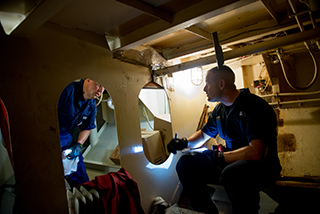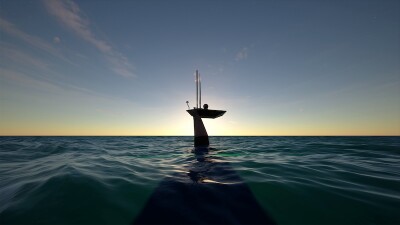By U.S. Coast Guard Petty Officer 2nd Class David Marin
Chief Warrant Officers Jeff Brown (left) and Aaron Studie (right) inspect a vessel's steering system in Baltimore, July 14, 2015. USCG photo by Petty Officer 2nd Class David R. Marin.Inspections guarantee the fulfillment of a required specification. Some, like skydiving, are easily seen as a necessity for safe operation and safety of the consumer. Do you think to look for an inspection sticker when you board a ferry, cruise around in a sailboat, take a water taxi or charter a fishing boat?
When it comes to boats in the U.S., the responsibility falls on Coast Guard marine inspectors to conduct the inspections of boats used for commercial purposes.
"Basically there are two different sides to marine inspections," said Chief Warrant Officer Aaron Studie, a marine inspector with Coast Guard Sector Baltimore. "There are the foreign vessels, which are handled by the Coast Guard's port state control department. The other side encompasses domestic vessels, which is what I currently do."
Domestic vessels are handled by the Coast Guard's inspections department and are further divided into two groups: small passenger vessels and deep-draft vessels.
Now a structured system, the history of marine inspections is fraught with challenges and disasters. In 1837, the explosion of the steamboat Pulaski off the coast of North Carolina claimed 100 lives. In response, a commercial vessel inspection act was passed in 1838 demanding the installation of fire-fighting and life-saving equipment.
Congress passed the Steamboat Act of 1852 following the death of 700 people in seven disasters within the period between December 1851 and July 1852. This act expanded the Act of 1838 and controlled inspections and licensing of steamships carrying passengers.
During the Civil War commercial vessel safety efforts were less regulated leading to the largest commercial maritime disaster in U.S. history. Somewhere between 1,500 and 1,800 passengers died when the sternwheeler Sultana caught fire after her boilers exploded and sank near Memphis, Tenn. She was carrying more than 2,000 people, the majority recently released Union prisoners of war, despite a legal capacity of only 376. The deaths aboard the Sultana led to the creation of the Steamboat Inspection Service in 1871.
"Unfortunately all the regulations we have stem from some tragedy," said Studie. "The Steamboat Inspection Service was a predecessor [of] our first branch of inspections."
Regulations have evolved over the years as the times have changed, but the purpose remains the same.
"I'm proud of the strides the maritime industry has made and the partnership that exists between the mariners, operators and regulators," said Lt. Cmdr. Eddie Lesane, chief of the inspection division at Sector Baltimore. "The ultimate goal is to ensure a safe, secure and environmentally sound commerce. There are plenty of examples of maritime partnerships that were established with the same goals in mind."
Today, marine inspectors check the ship's electrical, engineering and pollution prevention equipment. Inspectors also check life jackets and other survival equipment. "We check the hulls of the vessels," said Studie. "Whether they're made of wood, fiberglass, steel or aluminum, we check that they are in great shape and seaworthy."
The Coast Guard issues a five-year certificate of inspection, which requires an annual inspection.
"That's something boaters can look for," added Studie. "The inspected vessels all get stickers saying the vessel is inspected and when the expiration date is."
The evolution of marine inspection has led to regulations that protect the environment and provide a standard for the seaworthiness of the vessel and reliability of emergency equipment.
"What we provide is another set of eyes to ensure everyone is safe," said Studie. "We look to keep the boating public safe, to keep the playing field level for everyone and that everyone is held to the same standards."





